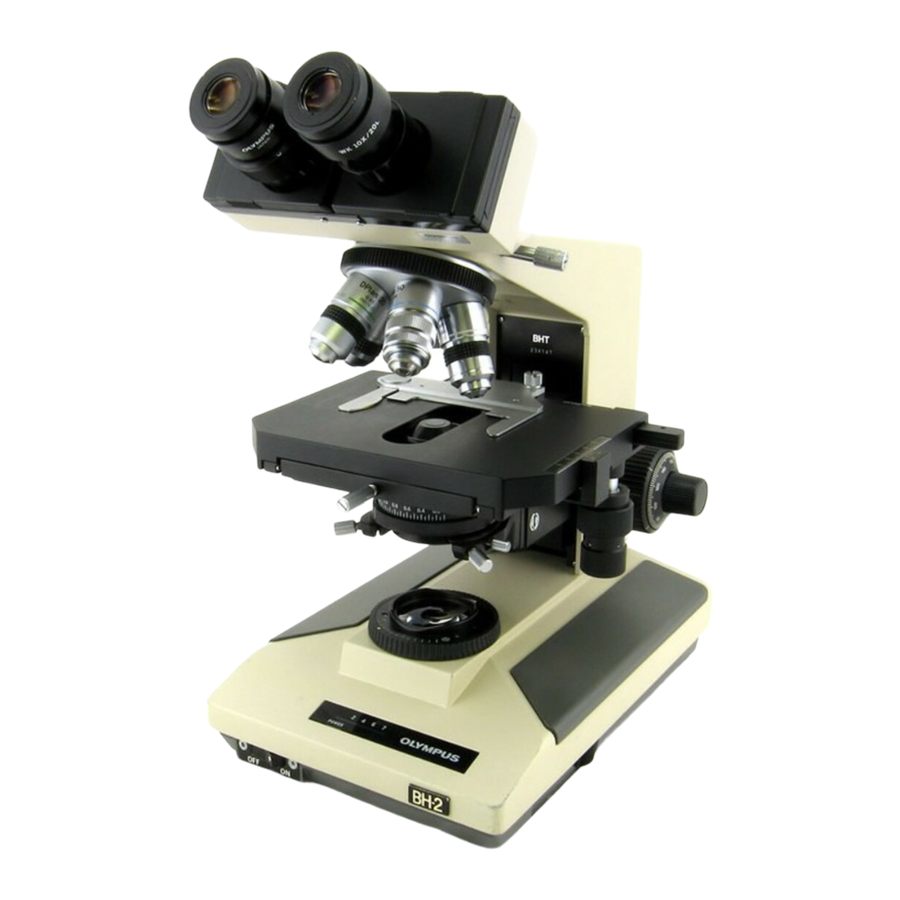Olympus BH2 Series 완전한 분해, 청소 및 재조립 - 페이지 8
{카테고리_이름} Olympus BH2 Series에 대한 완전한 분해, 청소 및 재조립을 온라인으로 검색하거나 PDF를 다운로드하세요. Olympus BH2 Series 40 페이지. Phase contrast
Olympus BH2 Series에 대해서도 마찬가지입니다: 문제 해결 및 조정 매뉴얼 (46 페이지), 완전한 분해, 청소 및 재조립 (23 페이지), 분해, 청소 및 재조립 (45 페이지), 매뉴얼 (6 페이지), 설치 매뉴얼 (9 페이지)

of the four quadrants of the cross-point depression (see
Figure
1).
Figure 1 – Head of a typical JIS screw
Supplies Needed
The following supplies will be needed to complete the
teardown, cleaning, and reassembly of the coaxial focus
mechanism in a BH-2 microscope stand.
• Cleaning solvents (see recommendations below)
• Loctite® 242 blue thread locker (item S2 of
• Loctite® 222 purple thread locker (item S3 of
• Lubricants (see recommendations below)
Recommended Lubricant Types
Either Plastilube® Brake Grease (item S1 of
TM
or Mobilith SHC
220 synthetic grease (item S4 of
Appendix
3) is recommended for use in the BH-2 coaxial
focus mechanism. These medium-consistency (NLGI2)
greases will remain stable and serviceable for many
years to come.
Recommended Solvents
Some sort of cleaning solvent will be needed to remove
the old grease from the various mechanical parts of the
coaxial focus mechanism. The list of solvents that can
be used include acetone, diethyl ether, heptane,
hexane, mineral spirits, turpentine, and xylene.
Regardless of which solvents are chosen, make sure
that adequate ventilation is present during the cleaning
process and that any necessary personal protective
equipment is utilized to minimize your exposure to the
solvents and their vapors. Consult the relevant safety
data sheet (MSDS or SDS) before using any unfamiliar
solvents.
Many of the solvents listed above are
flammable and their vapors may represent an explosion
hazard if mishandled. Whichever solvents are chosen
for the job, be sure to follow all of the manufacturer's
instructions and safety precautions when using and
storing the solvents. Acetone works well for Plastilube®
and mineral spirits works well for SHC
Complete Teardown, Cleaning, and Reassembly of the Olympus BH-2 Coaxial Focus Mechanism
Appendix
3)
Appendix
3)
Appendix
3)
TM
220 grease.
Solvent Compatibility with Painted Surfaces
Many solvents will damage the finish of painted
surfaces.
Isopropyl alcohol or 409 Cleaner may be
safely used to clean most painted surfaces.
Solvent Compatibility with Metal Parts
The solvents listed above are generally compatible with
the various unpainted metal parts. If unsure, minimize
the exposure time with the solvents by not soaking the
parts any longer than necessary to loosen the old
grease.
Solvent Compatibility with Plastic Parts
Many solvents will dissolve or damage plastic parts. Be
careful when cleaning the focus knobs and the pre-
focus lock collar, to prevent damage from solvents.
Even a very brief exposure to an incompatible solvent
can disfigure plastic parts. Regardless of which solvents
are chosen, minimize the time that the cleaning
solvents are in contact with plastic parts (i.e., do not
soak them in the solvent) and test for solvent
compatibility by applying a small amount to an
inconspicuous place, such as inside a knob, first. Never
use xylene, isopropyl alcohol or trichloroethylene to
clean nylon parts.
Xylene dissolves nylon, whereas
isopropyl alcohol and trichloroethylene will cause
swelling of nylon due to solvent absorption. The list of
solvents generally considered safe for nylon includes
acetone, diethyl ether, heptane, mineral spirits,
naphthalene, and turpentine.
Servicing the Coaxial Focus Assembly
Remove the Accessories from the Stand
Before beginning the teardown, remove all the major
components from the microscope stand (i.e., AC power
cord, condenser, x-y stage, eyepieces, viewing head,
objectives, and nosepiece, if applicable). This will make
the stand easier to maneuver and will prevent
inadvertent damage to these components during the
teardown and reassembly process. Be sure to protect
these components from dust and damage while they
are not installed on the stand.
Protect the Exposed Mounting Dovetails
Once the various accessories have been removed from
the stand, cover the top of the microscope pillar arm
(i.e., the exposed mounting dovetails for the viewing
head and nosepiece, if applicable) with a clean plastic
bag and secure this with a rubber band or adhesive tape
to keep dust out (see
important on BHSU and BHTU stands, which have an
optical correction lens located just below the viewing
head to correct for the difference in tube length
introduced with the reversed nosepiece.
Figure
2).
This is especially
Revision 4
Page 8 of 40
